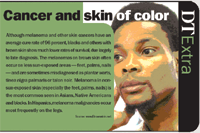- General Dermatology
- Eczema
- Chronic Hand Eczema
- Alopecia
- Aesthetics
- Vitiligo
- COVID-19
- Actinic Keratosis
- Precision Medicine and Biologics
- Rare Disease
- Wound Care
- Rosacea
- Psoriasis
- Psoriatic Arthritis
- Atopic Dermatitis
- Melasma
- NP and PA
- Skin Cancer
- Hidradenitis Suppurativa
- Drug Watch
- Pigmentary Disorders
- Acne
- Pediatric Dermatology
- Practice Management
- Prurigo Nodularis
Article
Prime first, proceed with caution
Berkeley, Calif. - Dermatologists can perform most cosmeticprocedures on blacks with Fitzpatrick IV-VI skin types, exceptlaser resurfacing, because the risk of scarring is too high.
Berkeley, Calif. - Dermatologists can perform most cosmetic procedures on blacks with Fitzpatrick IV-VI skin types, except laser resurfacing, because the risk of scarring is too high.
"The byword for all procedures," says Terri Dunn, M.D, "is to prime the skin beforehand and proceed cautiously, especially when doing procedures such as microdermabrasion or chemical peels."

Many patients begin treating hyperpigmentation with family remedies, such as cocoa butter.
"It's a myth passed down generation to generation," Dr. Dunn says. "It doesn't fade dark spots, but it can clog pores and cause acne."
She prefers hydroquinone, a proven bleaching agent, but will also consider chemical peels and microdermabrasion for patients with resistant skin. These patients get a three-to-six-week regimen of alpha hydroxy acid, hydroquinone, and a retinoid to toughen their skin and reduce the incidence of complications.

Dermatosis papulosa nigra
These small, round, benign bumps are a function of genes and sun exposure, and arise primarily on the face and neck. A bleaching regimen prior to treatment minimizes the risk of hyperpigmentation. Treatment itself depends on size of the papules.
"If they are very small, I use an electrocautery," Dr. Dunn says. "If they are larger, I freeze with liquid nitrogen."
Keloids
Ear piercing and nicks from close cropping of the nape of the neck are common causes of keloids, but these thick scars can also emerge spontaneously from any skin laceration, however minor.
Treatment is tricky due to a risk of causing larger, worse keloids.
Says Dr. Dunn, "I don't typically excise the large ones at all, because the recurrence rate is high. I inject them with cortisone to try and reduce the size and the symptoms, as some people complain of itchiness and pain. I do excise earlobe keloids and inject with cortisone as they are healing. The injections help reduce recurrence."
For keloids on the nape of the neck she uses cortisone injections plus a topical retinoid and steroid to reduce inflammation and induce exfoliation.
The dermatologist notes that needle punctures are unlikely to cause keloids, even in people who are prone to them, but the injection of deep fillers can lead to hyperpigmentation as a result of numerous needle punctures in the skin. To minimize risk from injecting fillers or botulinum toxin, she plans the procedure to minimize the number of punctures.
Other
Dr. Dunn reports that many of her male patients complain of pseudofolliculitis barbae. Caused by ingrown hairs, they also are known as razor bumps. She advises patients to shave in the direction of hair growth and to use a shaving cream that contains glycolic acid or alpha hydroxy acid. Dr. Dunn also advises these patients to consider laser hair removal for the beard area.
Treatment for unwanted facial hair in women is possible with electrolysis or long-wave lasers. Follow-up use of enzyme-inhibiting creams to slow hair growth will improve results.





